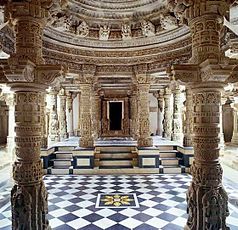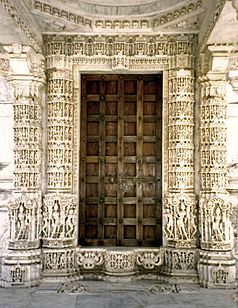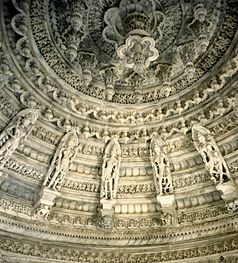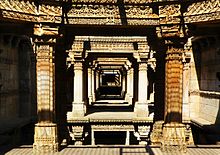- Dilwara Temples
-
The Jain Dilwara temples of India are located about 2½ kilometers from Mount Abu, Rajasthan's only hill station. These temples built by Chalukya[1][2] between the 11th and 13th centuries AD are world famous for their stunning use of marble. The five legendary marble temples of Dilwara are a sacred pilgrimage place of the Jains. Some consider them to be one of the most beautiful Jain pilgrimage sites in the world. The marble temples have an opulent entranceway, the simplicity in architecture reflecting Jain values like honesty and frugality. The temples are in the midst of a range of forested hills. A high wall shrouds the temple complex.
Although the Jains built some beautiful temples at other places in Rajasthan, some believe that none come close to these in terms of architectural perfection. The ornamental detail spreading over the minutely carved ceilings, doorways, pillars and panels is simply marvellous.
For the people who come to perform puja here, there are facilities to bathe and get ready. The facilities use passive solar power to heat up the water for bathing and other things. Guided tour hours for tourists are posted outside the temple. You might see occasional monkeys looking for food outside the temple area.
Contents
Five Unique Temples of Dilwara
There are 5 temples in all, each with its own unique identity. Each is named after the small village in which it is located. These are:
- Vimal Vasahi, dedicated to the first Jain Tirthankara, Rishabha.
- Luna Vasahi, dedicated to the 22nd Jain Tirthankara, Neminatha.
- Pithalhar, dedicated to the first Jain Tirthankar, Rishabha
- Khartar Vasahi, dedicated to the 23rd Jain Tirthankara, Parshva.
- Mahavir Swami, dedicated to the last Jain Tirthankara, Mahavira.
The most famous of these are the Vimal Vasahi and Luna Vasahi temples.
Vimal Vasahi Temple
This temple carved entirely out of white marble was built in 1021 by Vimal Shah, a minister of Bhimidev I, the Chalukya[3] King (Solanki Maharaja) of Gujarat. The temple is dedicated to Rishabha. The temple stands in an open courtyard surrounded by a corridor, which has numerous cells containing smaller idols of the Tirthankaras. The richly carved corridors, pillars, arches, and 'mandaps' or porticoes of the temple are simply amazing. The ceilings feature engraved designs of lotus-buds, petals, flowers and scenes from Jain and Hindu mythology.
The Rang manda is a grand hall supported by 12 decorated pillars and nicely carved out arches with a breathtaking central dome. On the pillars are carved female figurines playing musical instruments and 16 Vidhyadevis, or the goddesses of knowledge, each one holding her own symbol which is believed to be memorial of victorious Brahma Kumaris follower from last Kalpa.
The Navchowki is a collection of nine rectangular ceilings, each one containing beautiful carvings of different designs supported on ornate pillars. The Gudh mandap is a simple hall once you step inside its heavily decorated doorway. Installed here is the idol of Adi Nath or Lord Rishabdev, as he is also known. The mandap is meant for Aarti to the deity. The Hastishala (Elephant Cell) was constructed by Prithvipal, a descendant of Vimal Shah in 1147-49 and features a row of elephants in sculpture.
Luna Vasahi
The Luna Vashi temple is dedicated to Neminath. This magnificent temple was built in 1230 by two Porwad brothers - Vastupal and Tejpal - both ministers of a Virdhaval, the Vaghela ruler of Gujarat. The temple built in memory of their late brother Luna was designed after the Vimal Vashi temple. The main hall or Rang mandap features a central dome from which hangs a big ornamental pendent featuring elaborate carving. Arranged in a circular band are 72 figures of Tirthankars in sitting posture and just below this band are 360 small figures of Jain monks in another circular band. The Hathishala or elephant cell features 10 beautiful marble elephants neatly polished and realistically modelled.
The Navchowki features some of the most magnificent and delicate marble stone cutting work of the temple. Each of the nine ceilings here seems to exceed the others in beauty and grace. The Gudh mandap features a black marble idol of the 22nd Jain Tirthankar Neminatha. The Kirthi Stambha is a big black stone pillar that stands on the left side of the temple. The pillar was constructed by Maharana Kumbha of Mewar. The remaining three temples of Dilwara are smaller but just as elegant as the other two.
Pittalhar Temple
This temple was built by Bhima Shah, a minister of Sultan Begada of Ahmedabad. A massive metal statue of first Jain Tirthankara Rishabha Dev (Adinath), cast in five metals, is installed in the temple. The main metal used in this statue is 'Pital' (brass), hence the name 'Pittalhar'. The Shrine consists of a main Garbhagriha, Gudh mandap and Navchowki. It seems that the construction of Rangmandap and the corridor was left unfinished. The old mutilated idol was replaced and installed in 1468-69 AD weighing 108 maunds (about 40 quintals or four metric tons) according to the inscription on it. The image was cast by an artist 'Deta' which is 8 ft (2.4 m). high, 5.5 ft (1.7 m). broad and the figure is 41 inches (1,000 mm) in height. In Gudh Mandap on one side, a big marble Panch-Tirthi sculpture of Adinath is installed.
Parshvanatha Temple
This temple, dedicated to Parshva, was built by Mandlik and his family in 1458-59 It consists of a three storied building, the tallest of all the shrines at Dilwara. On all the four faces of the sanctum on the ground floor are four big mandaps. The outer walls of the sanctum comprise beautiful sculptures in gray sandstone, depicting Dikpals, Vidhyadevis, Yakshinis, Shalabhanjikas and other decorative sculptures comparable to the ones in Khajuraho and Konarak.
Mahavir Swami Temple
This is a small structure constructed in 1582 and dedicated to Mahavira. There are pictures on the upper walls of the porch painted in 1764 by the artists of Sirohi.
See also
- Hangal
- Chalukya
- Western Chalukyas
- Western Chalukya architecture
References
- ^ "IMAGES OF NORTHERN INDIA". http://philae.sas.upenn.edu/Hindi/hindipix.html. Retrieved 2009-03-13.
- ^ "Biyari in Manasollasa, A Chalukya Garb Primer, Introduction - so where are all the Chalukya Pictures?". http://www.generalism.net/lakshmi/Clothing/Chalukya/Chalukya_Biyari.html. Retrieved 2009-03-13.
- ^ "Dilwara Jain Temple". http://www.tourindiarajasthan.com/mountabu.html. Retrieved 2009-03-13.
External links
- Dilwara Temples ( Mount Abu )
- The Delwara Temples at Mount Abu Jaina Architecture in India, ch.1
- Delware Jain Temples : Mount Abu
State of Rajasthan (India) Rajasthan Topics Major cities 
Divisions Districts Ajmer · Alwar · Banswara · Baran · Barmer · Bharatpur · Bhilwara · Bikaner · Bundi · Chittorgarh · Churu · Dausa · Dholpur · Dungarpur · Hanumangarh · Jaipur · Jaisalmer · Jalore · Jhalawar · Jhunjhunu · Jodhpur · Karauli · Kota · Nagaur · Pali · Pratapgarh · Rajsamand · Sawai Madhopur · Sikar · Sirohi · Sri Ganganagar · Tonk · UdaipurBadami • Aihole • Pattadakal • Mahakuta • Sudi • Banashankari • Lakkundi • Dambal • Gadag • Mahadeva Temple, Itagi • Lakshmeshwara• Annigeri • Kundgol • Chaudayyadanapura • Galaganatha • Hangal • Hooli • Jalasangvi • Basavakalyan • Manyakheta • Chandramouleshwara Temple Unkal Hubli-Dharwad • Haveri • Narasimhula Palle • Elephanta Caves • Ajanta cave #1 paintings • Sangli • Sangli State • Kolhapur • Latur • Dhule • Solapur • Manapura • Mumbai • Akola • Nanded • Naldurg • Dilwara Temples Mount Abu Rajasthan • Rani ki vav, stepwell, Patan Gujarat • Hottal near Deglur • Junagadh • Danteshwari Temple Dantewada Chatthisgarh • Kamboi • Naldurg • Navsari • Aurad • 9 storey building in Barabati Fort
Coordinates: 24°36′33.5″N 72°43′23″E / 24.609306°N 72.72306°E
Categories:- Jain temples in Rajasthan
- Mount Abu
- Rajput era
- Chalukya dynasty
Wikimedia Foundation. 2010.




